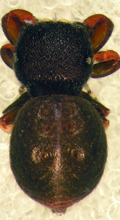Latest News Archive
Please select Category, Year, and then Month to display items
03 September 2021
|
Story Burneline Kaars
![]()
The University of the Free State invites students and staff to a webinar titled, ‘The COVID vaccine and YOU’. Dr Samantha Potgieter, infectious disease expert at the Universitas Academic Hospital and affiliated Lecturer in the Department of Internal Medicine, will answer questions from staff about the COVID-19 vaccine and how it affects them. The webinar will address questions such as the following:
• what vaccination is and how it works
• how vaccines are developed and how we know they are safe and effective
• how the COVID-19 vaccine works and how it can protect you
• the side effects of the vaccine
• the risks vs benefits of the vaccine.
Date: Friday 10 September 2021
Time: 11:00-12:00
UFS entomologists describe a new spider species
2014-02-19
|
 |
It is about 3mm in size and almost looks like a ladybird, but this new spider is the cause of great excitement at the University of the Free State’s (UFS’s) Department of Zoology and Entomology.
The new species of spider, now known as Rhene amanzi, was recently described for the first time and was ‘introduced’ to other arachnologist at the recent congress of the African Arachnology Society at Amanzi Private Reserve.
Dr Charles Haddad, senior lecturer in the UFS’s Department of Zoology and Entomology, said they already stumbled upon the male spider in 2010 when a student was doing research at the reserve. After a very long process, the spider was described and a couple of weeks ago, whilst at the congress, they also found the female.
“Up to now we only know that the spider lives in trees in the Brandfort area. The range could be wider, but since it was only described recently, other arachnologists will only now be able to identify accurately.”
Dr Haddad says they still have to determine how many eggs the female is able to lay, what the spider’s life cycle looks like and what their habitual preferences are.
“What we do know is that it probably isn’t poisonous and that the spider imitates a ladybird in order to protect itself against predators.”